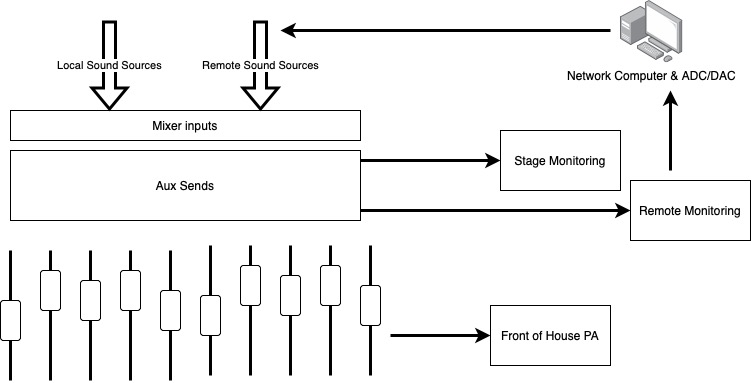Audio Engineering for Network Music Performances
From hybrid online conferences to network music performances, the job of the sound technician is growing in complexity. Here we will take a look at the added considerations for the FOH engineer working with network music performances (NMPs).
How much more difficult could it POSSIBLY be?
If you’re already a competant sound engineer who’s comfortable in front of the board you might wonder what the fuss is about. Is it not just more of the same? If you already know your high shelves from your aux sends, then the basic principals will still serve you well, however, expanding your live sound across a network connection will throw up a few key complications, some of which are covered here. In these examples we will assume a connections between two locations.
Doubling the Setup
A NMP essentially means you are working across more than one location. Firstly, your “front of house” where your audience and the main focus of your performers will be located. Secondly, whatever other location (or locations) your remote performers are performing from. With two locations this inevitably means two sets of audio equipment for audio routing, analogue/digital conversion, networking etc.
This represents a clear addition to the workload in terms of sheer quantity, a longer load-in and setup across two locations. Take this into consideration when planning.
Double the Sound Check AND Fold Back

The diagram above illustrates the additional layers of complexity for the FOH engineer. Notably that as well as bringing in sound sources “locally” (ie in the same location as you), you will also need to consider the sound sources you receive from the network. Will you receive a submix of the remote sources or will they be separated? Do you have enough channels on the mixer? Remember to label your channel strips meaningfully.
You will then need to take into consideration the balance of local and remote sources when creating your FOH and monitor mixes. Speaking of monitoring, you will have to create an additional monitor mix of your local sources to send to the remote musicians for monitoring. This added complexity will extend your sound checks significantly.
As well as testing the sound, you will also need to establish and test the network connection and receiving of the remote audio. Ideally you will have a separate technician handling network connectivity but it will still need to be factored in to sound checks.
Communication is Key
Talkback microphones are easily overlooked but absolutely vital when setting up for NMPs. Lines of talkback communication will be necessary across several situations:
- Local and remote musicians will need to communicate with each other via monitors, isolated from the FOH.
- Likewise, local and remote audio engineers will need to communicate with each other, also isolated from the FOH and possibily also the performers.
- Musicians may need to communicate with remote engineers to change monitor mixes or identify issues.
- Remote musicians and technicians need to be cued for the beginnings and ends of performances
And a Whole Host More
These were just some of the most immediate additional complexities for audio engineering a NMP. Hopefully this has helped you begin thinking about the technical considerations of such a performance. This is just the beginning, though. Below are some further complications to take into consideration when planning your own network music performance.
- Making sure you pay attention to the remote musicians when mixing (they are easy to deprioritise)
- Having a desk with enough I/O to accommodate the added complexity
- Signal noise/ground hum on signals received remotely
- Gain staging local and remote signals
- Network connection stability and audio fidelity
- Video monitoring
- Staging/stage plotting
